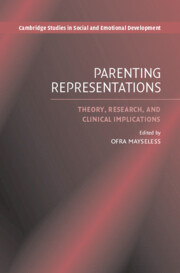Book contents
- Frontmatter
- Contents
- List of Illustrations
- List of Tables
- List of Appendixes
- List of Contributors
- Preface
- Acknowledgments
- Part One Theoretical Perspectives
- Part Two Research Applications
- Part Three Clinical Implications
- 9 Intergenerational Transmission of Dysregulated Maternal Caregiving: Mothers Describe Their Upbringing and Childrearing
- 10 Good Investments: Foster Parent Representations of Their Foster Children
- 11 Intergenerational Transmission of Experiences in Adolescence: The Challenges in Parenting Adolescents
- 12 Interplay of Relational Parent–Child Representations from a Psychoanalytic Perspective: An Analysis of Two Mother–Father–Child Triads
- 13 Why Do Inadequate Parents Do What They Do?
- Index
- Cambridge Studies in Social and Emotional Development
- References
11 - Intergenerational Transmission of Experiences in Adolescence: The Challenges in Parenting Adolescents
from Part Three - Clinical Implications
Published online by Cambridge University Press: 10 July 2009
- Frontmatter
- Contents
- List of Illustrations
- List of Tables
- List of Appendixes
- List of Contributors
- Preface
- Acknowledgments
- Part One Theoretical Perspectives
- Part Two Research Applications
- Part Three Clinical Implications
- 9 Intergenerational Transmission of Dysregulated Maternal Caregiving: Mothers Describe Their Upbringing and Childrearing
- 10 Good Investments: Foster Parent Representations of Their Foster Children
- 11 Intergenerational Transmission of Experiences in Adolescence: The Challenges in Parenting Adolescents
- 12 Interplay of Relational Parent–Child Representations from a Psychoanalytic Perspective: An Analysis of Two Mother–Father–Child Triads
- 13 Why Do Inadequate Parents Do What They Do?
- Index
- Cambridge Studies in Social and Emotional Development
- References
Summary
Abstract
The chapter focuses on the nature of intergenerational transmission of parenting during adolescence, namely how parents' past experiences with their own parents in adolescence are related to their parenting of their adolescents. This issue was examined in relation to attachment theory and psychoanalytic conceptualizations. Five case studies from a research project that included seventy 15-year-old adolescents (35 girls) and their parents are presented. Parents were interviewed with regard to their experiences in adolescence and their representations with regards to their relationship with their adolescent offspring. Adolescents were interviewed about their relationships with both parents. The case studies involve narratives of parents with favorable and difficult experiences and describe parents who have and have not resolved their difficult experiences. The cases presented demonstrate the powerful grip of experiences in one's family of origin, revealing that the past continues to play an active role in present life. It also demonstrates how parents try to correct and undo their past, in many cases unsuccessfully. It is argued that the ability to achieve flexible and integrative reflection of the past enables people to accept the imperfection of their parents, themselves, and their children, to relinquish the need to fulfill longed-for wishes, and paves the way to breaking the intergenerational transmission of adverse parenting.
A large body of research and theoretical conceptualizations has been devoted to the study of developmental processes in adolescence, focusing mainly on the challenges experienced by the adolescents and their social context.
- Type
- Chapter
- Information
- Parenting RepresentationsTheory, Research, and Clinical Implications, pp. 319 - 351Publisher: Cambridge University PressPrint publication year: 2006
References
- 12
- Cited by



